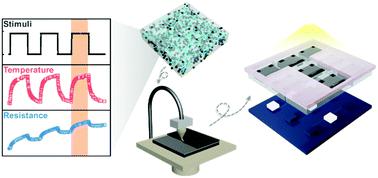当前位置:
X-MOL 学术
›
Mater. Horiz.
›
论文详情
Our official English website, www.x-mol.net, welcomes your
feedback! (Note: you will need to create a separate account there.)
Artificial visual memory device based on a photo-memorizing composite and one-step manufacturing
Materials Horizons ( IF 12.2 ) Pub Date : 2020-04-06 , DOI: 10.1039/d0mh00312c Meng Xiao 1, 2, 3, 4, 5 , Huide Wang 5, 6, 7, 8, 9 , Jianfeng Liu 1, 2, 3, 4, 5 , Hui Yang 5, 10, 11, 12 , Han Zhang 5, 6, 7, 8, 9
Materials Horizons ( IF 12.2 ) Pub Date : 2020-04-06 , DOI: 10.1039/d0mh00312c Meng Xiao 1, 2, 3, 4, 5 , Huide Wang 5, 6, 7, 8, 9 , Jianfeng Liu 1, 2, 3, 4, 5 , Hui Yang 5, 10, 11, 12 , Han Zhang 5, 6, 7, 8, 9
Affiliation

|
The functional deficiency between physically separated electronic components makes the up-to-date artificial photo memory devices undergo an intricate preparation and assembly process for the discrete elements, modules and final product. In this research, a multi-functional composite, which consists of conductive nanoparticles with a photothermal conversion effect and a polymeric matrix with memory characteristics, is proposed to realize the sensing and successive memory of optical information in the same material instead of device integration. Nanoparticles in the composite can convert light into heat, and heat can change the irreversible viscous flow of the polymers, which results in changing the distribution distance of conductive nanoparticles in the matrix, as well as the resistance of the composite. Therefore, the composite itself can realize light perception and memory. The composite can mimic multiple basic neuro behaviors. This new way of thinking about the polymer physical properties may open doors for polymers in the electronics area, which may be applied in future flexible and wearable electronics or even artificial intelligence with sensory demands.
中文翻译:

基于光记忆复合材料的人工视觉存储装置及一步制造
物理上分离的电子组件之间的功能缺陷使最新的人造光存储设备需要为离散的元件,模块和最终产品进行复杂的准备和组装过程。在这项研究中,提出了一种多功能复合材料,该材料由具有光热转换作用的导电纳米粒子和具有记忆特性的聚合物基质组成,以实现在同一材料中进行光学信息的传感和连续记忆,而不是器件集成。复合材料中的纳米颗粒可以将光转换为热量,热量可以改变聚合物的不可逆粘性流,从而导致导电纳米颗粒在基质中的分布距离以及复合材料的电阻发生变化。因此,复合材料本身可以实现光的感知和记忆。复合材料可以模仿多种基本的神经行为。这种思考聚合物物理性质的新方法可能会为电子领域中的聚合物打开大门,这可能会应用于未来的柔性和可穿戴电子设备,甚至是具有感官要求的人工智能。
更新日期:2020-04-06
中文翻译:

基于光记忆复合材料的人工视觉存储装置及一步制造
物理上分离的电子组件之间的功能缺陷使最新的人造光存储设备需要为离散的元件,模块和最终产品进行复杂的准备和组装过程。在这项研究中,提出了一种多功能复合材料,该材料由具有光热转换作用的导电纳米粒子和具有记忆特性的聚合物基质组成,以实现在同一材料中进行光学信息的传感和连续记忆,而不是器件集成。复合材料中的纳米颗粒可以将光转换为热量,热量可以改变聚合物的不可逆粘性流,从而导致导电纳米颗粒在基质中的分布距离以及复合材料的电阻发生变化。因此,复合材料本身可以实现光的感知和记忆。复合材料可以模仿多种基本的神经行为。这种思考聚合物物理性质的新方法可能会为电子领域中的聚合物打开大门,这可能会应用于未来的柔性和可穿戴电子设备,甚至是具有感官要求的人工智能。











































 京公网安备 11010802027423号
京公网安备 11010802027423号